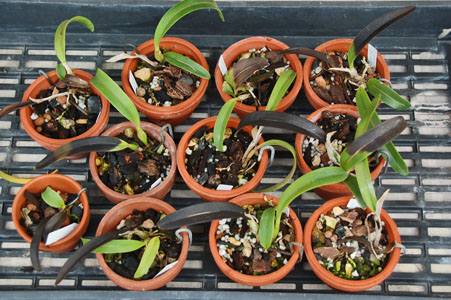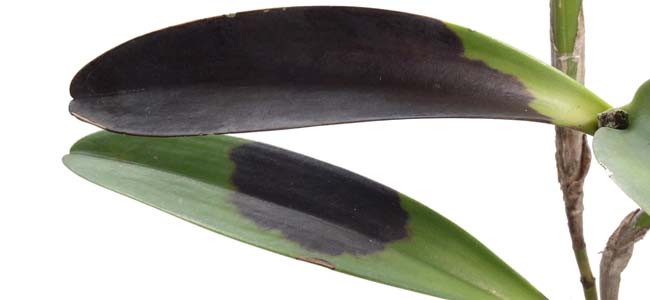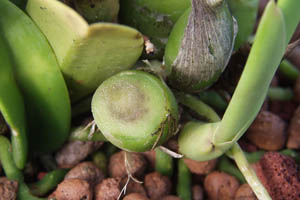|
Welcome to the AOS Beginner's Newsletter. We will be sending you monthly tips on how to grow orchids and help you get them to bloom again. In addition to the information presented here, we invite you to visit the AOS website at www.aos.org and check out the information found under ORCHID INFORMATION > ORCHID BASICS.
Is There a Fungus Among Us?

Black rot has decimated this tray of cattleya seedlings overnight.
We grow our orchids in an open shadehouse, which means that they get whatever Mother Nature gives them. A wet summer is following what was a wetter-than-usual winter. That in itself was enough to deal with because as you know, orchids generally follow a seasonal growth cycle. Even though most of the ones we all grow are from the tropics, they still prefer a cool, dry winter. They also do best with ample water during the growing season. As you might expect, our wet summer has made plant growth explode. Though the plants are growing tremendously, every morning I go out to check to see if any fungal infections have begun. Our prolonged rain prevents plants from drying out, sometimes for a full week or more. Wet foliage provides a perfect environment for fungus dispersal through splashing water. Based on past experience we have come to expect an outbreak of black rot under these
type of wet, humid conditions. Pythium ultimum (and/or Phytophthora cactorum) is ruthless and can destroy a collection of cattleyas in short order and those plants you do manage to save will be set back for years. Although cattleyas are its favorite host in our collection, it does not discriminate and will infect other genera, especially soft-leaved types such as Grammatophyllum, Stanhopea, Oncidium, etc, Black rot is our biggest nemesis but wet conditions can bring out other nasty fungi too.

Black rot on Guarianthe bowringiana.
It should be obvious that healthy plants are less susceptible to fungal infection just as healthy people are less likely to get sick. We have come full circle back to the topic of balance in orchid culture. While we want to grow our orchids as vigorously as possible during the summer, we want to avoid vulnerable soft growth and do whatever we can to prevent rot problems.
Soft growth can result from low light levels, too much nitrogen fertilizer
without increasing other culture variables and other stress-related causes and
is more susceptible to disease. Here are some suggestions for summertime orchid culture.
- Strive to maintain a balanced culture regime. If you find you are watering
plants more often in summer try to gradually provide more light and make sure
you fertilize regularly.
- Provide adequate air movement. The importance of ventilation in orchid culture cannot be overstated. Moving air promotes rapid drying of watered plants.
Roots that stay constantly wet will deteriorate more quickly than those that are
allowed to dry between waterings. Water standing on leaves provides a
place for fungus spores to incubate, especially Pythium species. Moving
air also helps keep leaf temperatures down. This is especially important in summer.
- Make sure your growing area is clean and free from debris. Decomposing leaves and other plant material under benches make a perfect breeding ground for fungus and bacteria.
- Excessive algae growth can keep surrounding areas overly damp and provide a fertile environment for fungi, We spray benches and the wooden structural parts of the shadehouse with an algaecide such as Physan or RD-20 in late spring and at least once again midway through the summer. As long as you don't subscribe to the "more is better" theory and mix strictly to label recommendations, plants can be sprayed as well. Too-strong solutions can burn soft-leaved orchids. Be advised that if you rely on live moss culture for pleurothallids and other pure-water orchids, these chemicals can kill moss.
- If you are not afraid to use agricultural chemicals*, prophylactic spraying of
plants with a broad-spectrum fungicide (such as Captan 50WP, Dithane M-45, Cleary's 3336, etc.) once or twice a season can provide protection against many fungal problems
 Should you be unfortunate enough to experience Black Rot or other fungal problems there are accepted treatment protocols. If a leaf is compromised to the point where it will be lost anyway, it is best to remove it. This is especially true with
Pythium. Cut the infected part off with sterile shears or a new single-edge razor blade. Cut at least a half-inch into good, unaffected tissue. If you can still see a dark dicoloration of tissue such as in the photo at left, cut deeper until you reach healthy, green plant tissue. Using a small amount of one of the fungicides mentioned above, mix with water to make a paste the consistency of heavy cream. Using a disposable cotton swab coat the cut edge of the healthy tissue. This would also be a good time to consider spraying the affected plant as well as nearby plants with a targeted fungicide to prevent further infection (Aliette WP, Subdue 2E, Truban 30WP). Keep the plant isolated and dry until the infection has abated.
If a leaf has only minor fungal spotting it can be left on the plant but should be sprayed top and bottom with an appropriate fungicide. Some hobbyists also like to dust with cinnamon.
Should you be unfortunate enough to experience Black Rot or other fungal problems there are accepted treatment protocols. If a leaf is compromised to the point where it will be lost anyway, it is best to remove it. This is especially true with
Pythium. Cut the infected part off with sterile shears or a new single-edge razor blade. Cut at least a half-inch into good, unaffected tissue. If you can still see a dark dicoloration of tissue such as in the photo at left, cut deeper until you reach healthy, green plant tissue. Using a small amount of one of the fungicides mentioned above, mix with water to make a paste the consistency of heavy cream. Using a disposable cotton swab coat the cut edge of the healthy tissue. This would also be a good time to consider spraying the affected plant as well as nearby plants with a targeted fungicide to prevent further infection (Aliette WP, Subdue 2E, Truban 30WP). Keep the plant isolated and dry until the infection has abated.
If a leaf has only minor fungal spotting it can be left on the plant but should be sprayed top and bottom with an appropriate fungicide. Some hobbyists also like to dust with cinnamon.
*When using any agricultural chemical always make sure the product is listed for the plants you intend to use it on. Follow label directions exactly. Wear protective clothing. Do not spray around children or pets. Wash thoroughly after spraying.
Greg Allikas
June 2012
|

